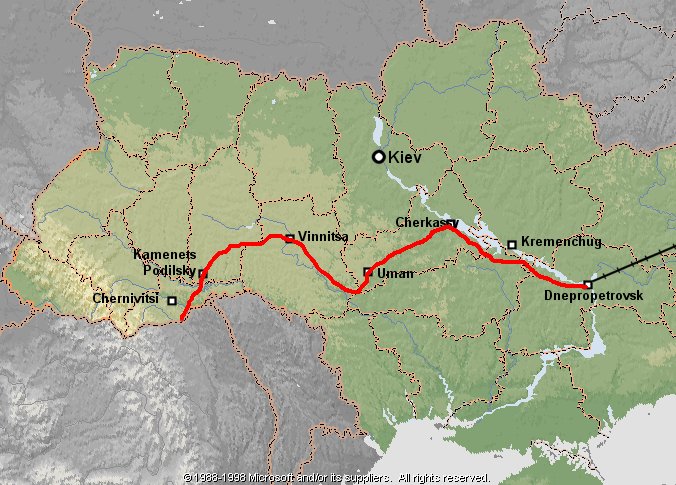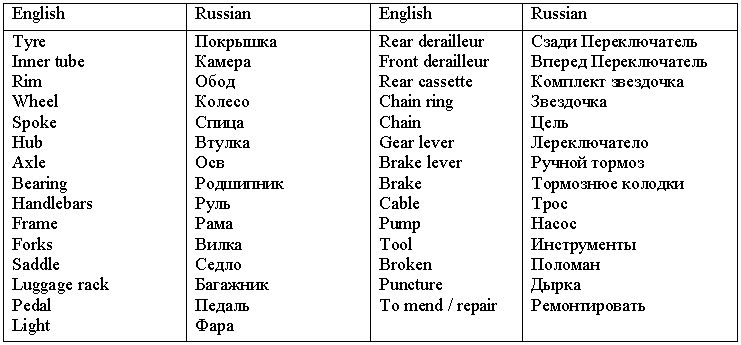

We were in Ukraine from the 17th April 2003 to the 18th May. We entered from the Romanian village of Siret, 30km from the Ukrainian town of Chernivitsi, and left by train from Dnepropetrovsk to Ufa in Russia.
There are two important things I want to say about Ukraine:
Ukraine is land of trees, perhaps because it is also a land of winds the roads are usually lined with trees. In the west (west of the Dneiper river) there are plenty of areas of forest which are ideal for wild camping. In the west the landscape is rolling hills, which reduce in height as you go eastwards, Ukraine is largely flat to the east of the Dneiper river. It is legal to camp in woodland anywhere, and except during the summer in the Crimea, to make a fire. Most of the roads and fields are lined with trees to cut down the wind and these serve for camping too at a pinch.
We found the people to be very friendly, for example we stopped at a petrol station cafe hoping for a bowl of soup, and found the people there in the middle of celebrating the boss's birthday with a banquet. We were immediately invited to join them and plied with copious vodka! Everywhere we stopped people wanted to know where we were from, how far we'd cycled, where we slept, how many months we'd been on the road and many more questions we couldn't understand.
The roads are quite good, at least if you stick to the more important ones, and all but the biggest are pleasantly quiet. The standard of driving is not very good though, with oncoming vehicles frequently overtaking as they pass and trucks expecting cyclists to pull onto the verge if they need space to overtake. Good maps at 1:500,000 scale are widely available from petrol stations for a dollar each (see www.ukrmap.com.ua). The IGN map available in the UK is wildly inaccurate. On the 1:500,000 maps we found the biggest classification of road (orange) to be a little too busy for our taste, the next two grades (pink and grey) to be ideal, and the yellow roads to be good while they were asphalt but they were frequently cobbles, gravel or even dirt.
In April the daytime temperature was 12-26°C and the night-time temperature was 5-15°C. No sign of any snow although there must have been a lot only a month before.
Everyone told us that the Crimea was beautiful and we should go there, but I'm afraid we didn't so I can't comment. The other mountainous area of Ukraine is the Carpathians in the far west, but unfortunately we didn't go there either.
Most small towns have cheap hotels, costing $2-$10 per night for a room. Take your bike into the room with you. We were told that petty crime is common, particularly in the cities, but the country had a safe feel to it and we never felt threatened anywhere.
Roadside cafes are quite common, we often stopped for a bowl of soup around lunchtime. In April it was difficult to buy vegetables and in any case it was almost as cheap to eat in a cafe as to buy the ingredients. Every village had at least one shop and they were open all day, seven days a week. We could always get tins of fish, bread, chocolate and vodka, but it was often hard to buy fruit, vegetables and jam. Markets in small towns sell vegetables and it was often possible to buy eggs, milk and potatoes from peasants sitting by the roadside. A white jug on a table outside a house means "milk for sale here", best to boil it!
Most towns have a market with several stalls selling bike spares. However you will have to search to find even basic spares for a western mountain bike, except in the big cities where I am told the markets sell western mountain bikes and spares. The main cities also have good bike shops selling western mountain bikes and spares for them.
We spent $9 a day between us during the three weeks we spent riding in Ukraine. This included five nights in cheap hotels.
Ticks can be a problem when camping in the forests. If going to the Crimea you should consider having the vaccination against tick borne encephalitis. This disease is widespread in Siberia but we were told it was only a problem in the Crimea in Ukraine. See the Russia page for further information about treatments.
If you can read Russian, check out www.velocity.kiev.ua, it has a bulletin board and other resources for cycling in Ukraine.
We met this club in Dnepropetrovsk and found them to be extremely friendly, hospitable and helpful to us in learning more about Ukraine and its people. They are keen to meet other cyclists, they are qualified cycle touring guides and they can offer the following:
To find out more, contact pana_n@pochtamt.ru and visit www.veltur.iatp.org.ua.
Ukrainians routinely take their bikes on trains and buses. The only problem you are likely to encounter is that it is important to have the right ticket and usually you need to purchase an additional baggage ticket for between 5% and 20% of the cost of your ticket. A Russian speaking friend will make this much easier. When travelling by train the best way is go "Platzcart", this is a third class ticket for a kind of dormitory on wheels. The beds are arranged in alcoves with four beds in each. Under the bottom bunks there is a storage locker with enough space for about six panniers. Above the top bunks is a shelf which can accomodate two bicycles with their front wheels removed. Bicycles must be wrapped in something, we bought some cheap polythene but you could use a tent groundsheet. Equipment in the storage locker is totally safe because no one can get into it while you are sleeping on the bunk. Note that 1st and 2nd class "coupes" are too small to get bicycles into. 3000km took about 48 hours and cost $30 each, plus $6 each for the bikes!
All you need to get a visa for Ukraine is the address of somebody in Ukraine that you are going to visit. Nothing is checked so it doesn't even need to be a real address. With this you can apply for a private visa, single or double entry for up to three months. Private visas no longer need to be registered so once in Ukraine there are no restrictions on where you can go. You should of course tell the border guards that you are going to visit the person whose address you gave when you applied for the visa. We got our visas in Bucharest for $30 each, it took a week. Strictly speaking you should fill in a Deklarisat customs form when you enter the country, but we weren't given one and it didn't seem to be a problem when we left.
Language is a problem unless you speak Russian, if you were touring only Ukraine it would be best to learn Ukrainian but if you are going on to Russia, save yourself the trouble and concentrate on Russian. All Ukrainians speak more Russian than the average western cycle tourist ever will! Learning the Cyrillic alphabet is essential because it is then possible to pronounce place names and guess the meanings of some words. Russian is the main language in use in Crimea and eastern Ukraine.
Here are some cycling terms in Russian:
